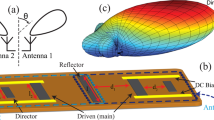Abstract
Indoor infrared communication systems is one of the possible ways of offering data rates in excess of 100 Mbit/s without the need for wiring. Multiple users can share an infrared channel by code division-multiple access (CDMA) techniques. However, the CDMA system performance is limited by both background noise and co-channel interference. In this paper we study the use of angle diversity for mitigating the effects of the noise and interference. The system considered uses on-off shift keying modulation with multibeam transmitters and imaging receivers. The overall system performance for different diversity combining techniques is evaluated and compared to a system without diversity. Numerical results for a 2-user CDMA system indicate that signal to noise and interference ratio (SNIR) improvement (over systems with no diversity) of 5 dB is obtained for at least 50% of an ensemble of 10000 sample evaluations. The generalized selection combining (GSC)--a new diversity technique yet to be implemented for infrared systems--offers the best performance even with its reduced complexity.
Similar content being viewed by others
References
T. Zahariadis, K. Pramataris, and N. Zervos, A comparison of competing broadband in-home technologies, Electronics and Communication Engineering Journal, vol. 14, no. 4, pp. 133-142, August 2002.
Special issue on wireless LANs, IEEE Wireless Communications, vol. 9, no. 6, December 2002.
M. HÅnnikÅinen, T. D. HÅmÅlÅinen, M. Niemi, and J. Saarinen, Trends in personal wireless data communications, Computer Communications, vol. 25, no. 1, pp. 84-99, January 2002.
J. M. Kahn and J. R. Barry, Wireless infrared communications, Proceedings of the IEEE, vol. 85, no. 2, pp. 265-298, June 1997.
D. Heatley, D. Wisely, I. Neild, and P. Cochrane, Optical wireless: The story so far, IEEE Communications Magazine, vol. 36, no. 12, pp. 72-82, December 1998.
G. W. Marsh and J. M. Khan, Channel reuse strategies for indoor infrared wireless communications, IEEE Transactions on Communications, vol. 45, no. 10, pp. 1280-1290, October 1997.
J. Bellon, M. J. N. Sibley, D. R. Wisely, and S. D. Greaves, Hub architectures for infra-red wireless networks in office environments, IEEE Proc.-Optoelectron., vol. 146, no. 2, pp. 78-82, April 1999.
V. Jungnickel, A. Forck, T. Haustein, U. Krüger, V. Pohl, and C. von Helmolt, Electronic tracking for wireless infrared communications, IEEE Transactions on Wireless Communications, vol. 2, no. 5, pp. 989-999, September 2003.
N. Karafolas and D. Uttamchandani, Optical fiber code division multiple access networks: A review, Optical Fiber Technology, vol. 2, no. 2, pp. 149-168, April 1996.
K. Kitayama, H. Sotobayashi, and N. Wada, Optical code division multi-plexing OCDM and its applications to photonics networks, IEICE Trans. Fundamentals, vol. E82-A, no. 12, pp. 2616-2626, December 1999.
A. J. Mendez, R. M. Gagliardi, H. X. C. Feng, J. P. Heritage, and J. M. Morookian, Strategies for realizing optical CDMA for dense, high-speed, long span, optical network applications, Journal of Lightwave Technology, vol. 18, no. 12, pp. 1685-1696, December 2000.
A. Stok and E.H. Sargent, The role of optical CDMA in access networks, IEEE Communications Magazine, vol. 40, no. 9, pp. 83-87, September 2002.
H. H. Chan, J. M. H. Elmirghani, R. A. J. Cryan, M. Hawkins, and T. Robbins, Performance analysis of indoor infrared wireless networks utilising PPM CDMA, in IEEE International Conference on Communications, Dallas, USA, June 1996, vol. 3, pp. 1467-1471.
S. Zahedi and J. A. Salehi, A photon counting approach to the performance analysis of indoor wireless infrared CDMA networks, in Proceedings of the 11th IEEE International Symposium on Personal, Indoor and Mobile Radio Communications, London, UK, September 2000, vol. 2, pp. 928-932.
R. Matsuo, M. Matsuo, T. Ohtsuki, and I. Sasase, Performance analysis of indoor infrared wireless systems using OOK CDMA on a difusse channel, IEICE Trans. Commun., vol. J83-B, no. 7, pp. 970-979, July 2000.
H. Yamaguchi, R. Matsuo, T. Ohtsuki, and I. Sasase, Equalization for infrared wireless systems using OOK-CDMA, IEICE Trans. Commun., vol. E85-B, no. 10, pp. 2292-2299, October 2002.
P. Djahani and J. M. Khan, Analysis of infrared wireless links employing multibeam transmitters and imaging diversity receivers, IEEE Transactions on Communications vol. 48, no. 12, pp. 2077-2088, December 2000.
S.T. Jivkova and M. Kavehrad, Multispot diffusing configuration for wireless infrared access, IEEE Transactions on Communications, vol. 48, no. 6, pp. 970-978, June 2000.
J. B. Carruthers and J. M. Kahn, Angle diversity for nondirected wireless infrared communication, IEEE Transactions on Communications, vol. 48, no. 6, pp. 960-969, June 2000.
D. C. O'Brien, G. E. Faulkner, K. Jim, E. B. Zyambo, D. J. Edwards, M. Whitehead, P. Stavrinou, G. Parry, J. Bellon, M. J. Sibley, V. A. Lalithambika, V. M. Joyner, R. J. Samsudin, D. M. Holburn, and R. J. Mears, High-speed integrated transceivers for optical wireless, IEEE Communications Magazine, vol. 43, no. 3, pp. 58-62, March 2003.
A. P. Tang, J. M. Kahn, and K. P. Ho, Wireless infrared communications links using multi-beam transmitters and imaging receivers, in IEEE International Conference on Communications, Dallas, USA, June 1996, vol. 1, pp. 180-186.
R. Ramaswami and S. N. Kumar, Optical networks: a practical perspective, Kaufmann, San Francisco, 2002.
N. Kong, Average signal-to-interference-plus-noise ratio of a generalized optimum selection combiner for non-indentical independent Rayleigh fading channels in the presence of co-channel interference, in IEEE International Conference on Communications, Helsinki, Finland, June 2001, vol. 4, pp. 990-994.
G. Einarsson, Principles of Lightwave Communications, Wiley, Chichester, 1996.
T. E. Stern and K. Bala, Multiwavelength Optical Networks A Layered Approach, Addisson-Wesley, Reading, 1999.
F. R. K. Chung, J. A. Salehi, and V. K. Wei, Optical orthogonal codes: design, analysis and applications, IEEE Transactions on Information Theory, vol. 35, no. 3, pp. 595-604, May 1989.
J. Salehi, Code division multiple access techniques in optical fiber networks part 1: Fundamental principles, IEEE Transactions on Communications, vol. 37, no. 8, pp. 824-833, August 1989.
Author information
Authors and Affiliations
Rights and permissions
About this article
Cite this article
Mutafungwa, E., Yong, L. Performance of Indoor Infrared Wireless CDMA Systems with Angle Diversity. International Journal of Infrared and Millimeter Waves 25, 365–381 (2004). https://doi.org/10.1023/B:IJIM.0000017905.71535.f1
Issue Date:
DOI: https://doi.org/10.1023/B:IJIM.0000017905.71535.f1




